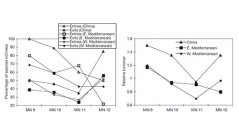

 Geodiversitas
28 (3) - Pages 499-516
Geodiversitas
28 (3) - Pages 499-516Both China and Greece have abundant fossils of the late Miocene Hipparion fauna. The habitat of the Hipparion fauna in Greece was a sclerophyllous evergreen woodland. The Chinese late Miocene Hipparion fauna is represented respectively in the Guonigou fauna (MN 9), the Dashengou fauna (MN 10), and the Yangjiashan fauna (MN 11) from Linxia, Gansu, and the Baode fauna (MN 12) from Baode, Shanxi. According to the evidence from lithology, carbon isotopes, paleobotany, taxonomic framework, mammalian diversity and faunal similarity, the paleoenvironment of the Hipparion fauna in China was a subarid open steppe, which is different from that of Greece. The red clay bearing the Hipparion fauna in China is windblown in origin, i.e. eolian deposits. Stable carbon isotopes from tooth enamel and paleosols indicate that C3 plants dominated the vegetation during the late Miocene in China. Pollens of xerophilous and sub-xerophilous grasses show a signal of steppe or dry grassland. Forest mammals, such as primates and chalicotheres, are absent or scarce, but grassland mammals, such as horses and rhinoceroses, are abundant in the Chinese Hipparion fauna. The species richness of China and Greece exhibits a similar trend with a clear increase from MN 9 to MN 12, but the two regions have low similarities at the species level. The entry of Hipparion led to a comparable radiation in China and Greece, but their dietary evolution is different. In conclusion, the ecosystems of the Chinese and Greek Hipparion faunas have an obvious dissimilarity in the late Miocene.
Hipparion fauna, late Miocene, paleoecology, China, Greece